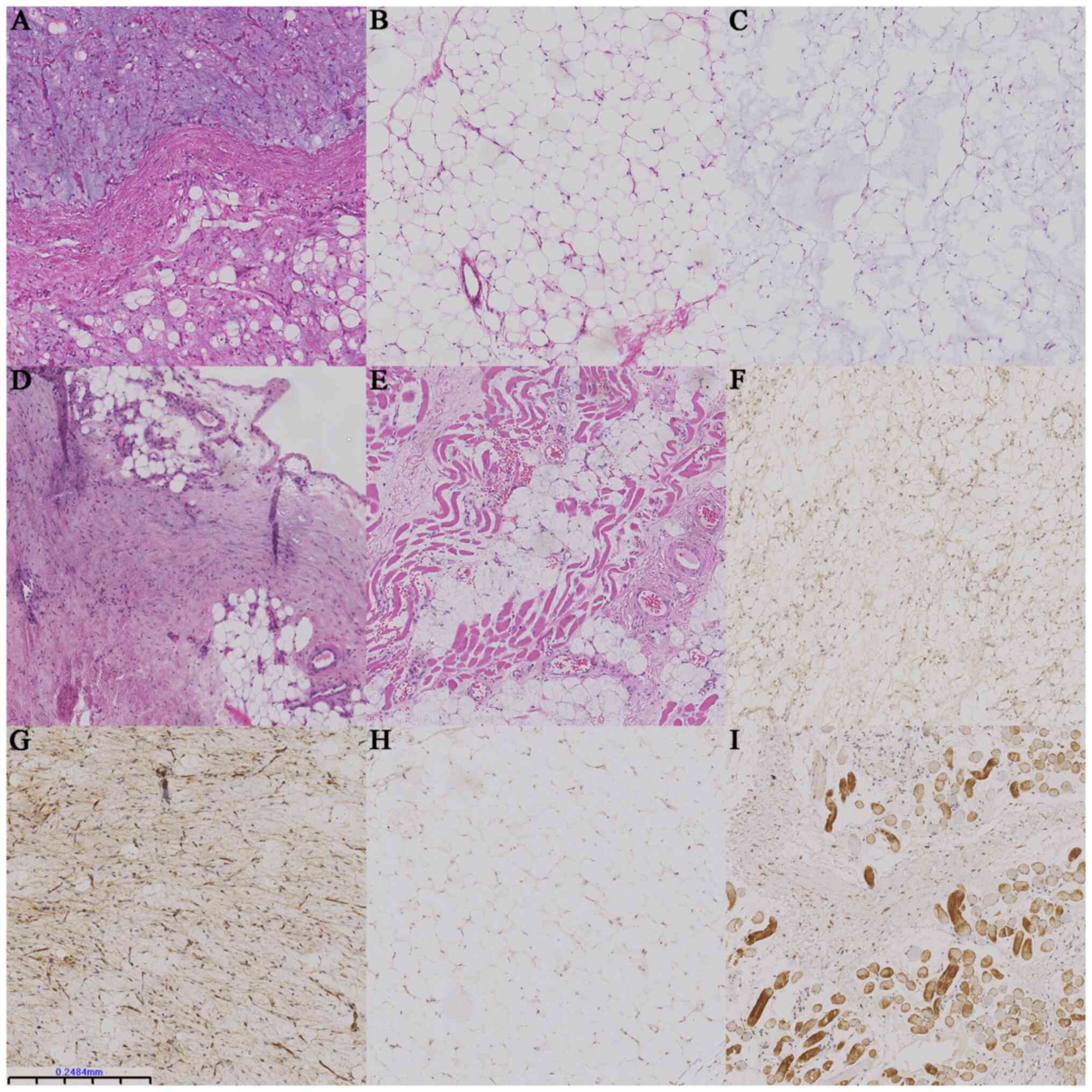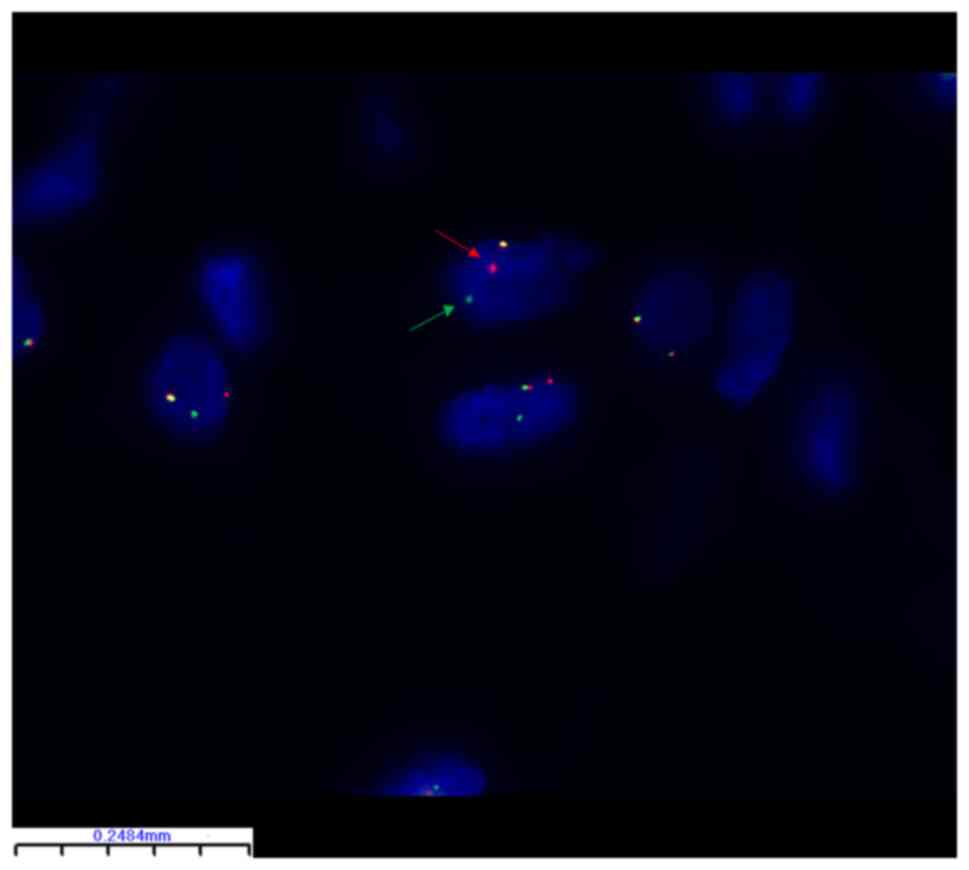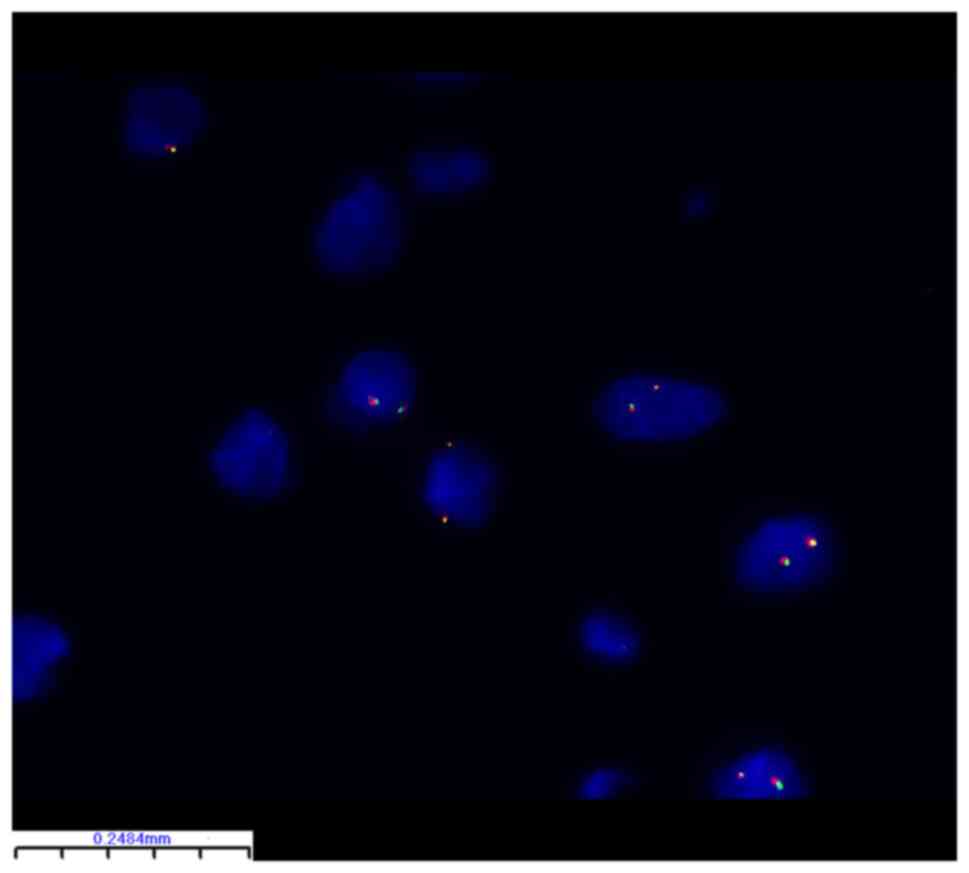|
1
|
Speer AL, Schofield DE, Wang KS, Shin CE,
Stein JE, Shaul DB, Mahour GH and Ford HR: Contemporary management
of lipoblastoma. J Pediatr Surg. 43:1295–1300. 2008.PubMed/NCBI View Article : Google Scholar
|
|
2
|
Putra J and Al-Ibraheemi A: Adipocytic
tumors in children: A contemporary review. Semin Diagn Pathol.
36:95–104. 2019.PubMed/NCBI View Article : Google Scholar
|
|
3
|
Spătaru RI, Cîrstoveanu C, Iozsa DA,
Enculescu A, Tomescu LF and Șerban D: Lipoblastoma: Diagnosis and
surgical considerations. Exp Ther Med. 22(903)2021.PubMed/NCBI View Article : Google Scholar
|
|
4
|
Jandali D, Heilingoetter A, Ghai R, Jeffe
J and Al-Khudari S: Large parotid gland lipoblastoma in a teenager.
Front Pediatr. 6(50)2018.PubMed/NCBI View Article : Google Scholar
|
|
5
|
Besouw MT, Verlinde PF, Uyttebroeck AM and
Renard MM: Lipoblastoma and lipoblastomatosis: Especially in
children. Ned Tijdschr Geneeskd. 155(A3467)2011.PubMed/NCBI(In Dutch).
|
|
6
|
McVay MR, Keller JE, Wagner CW, Jackson RJ
and Smith SD: Surgical management of lipoblastoma. J Pediatr Surg.
41:1067–1071. 2006.PubMed/NCBI View Article : Google Scholar
|
|
7
|
Voz ML, Mathys J, Hensen K, Pendeville H,
Van Valckenborgh I, Van Huffel C, Chavez M, Van Damme B, De Moor B,
Moreau Y and Van de Ven WJM: Microarray screening for target genes
of the proto-oncogene PLAG1. Oncogene. 23:179–191. 2004.PubMed/NCBI View Article : Google Scholar
|
|
8
|
Nitta Y, Miyachi M, Tomida A, Sugimoto Y,
Nakagawa N, Yoshida H, Ouchi K, Tsuchiya K, Iehara T, Konishi E, et
al: Identification of a novel BOC-PLAG1 fusion gene in a case of
lipoblastoma. Biochem Biophys Res Commun. 512:49–52.
2019.PubMed/NCBI View Article : Google Scholar
|
|
9
|
Juma AR, Damdimopoulou PE, Grommen SV, Van
de Ven WJ and De Groef B: Emerging role of PLAG1 as a regulator of
growth and reproduction. J Endocrinol. 228:R45–R56. 2016.PubMed/NCBI View Article : Google Scholar
|
|
10
|
Chen KS, Stroup EK, Budhipramono A,
Rakheja D, Nichols-Vinueza D, Xu L, Stuart SH, Shukla AA, Fraire C,
Mendell JT and Amatruda JF: Mutations in microrna processing genes
in wilms tumors derepress the IGF2 regulator PLAG1. Genes Dev.
32:996–1007. 2018.PubMed/NCBI View Article : Google Scholar
|
|
11
|
Patz M, Pallasch CP and Wendtner CM:
Critical role of micrornas in chronic lymphocytic leukemia:
Overexpression of the oncogene PLAG1 by deregulated mirnas. Leuk
Lymphoma. 51:1379–1381. 2010.PubMed/NCBI View Article : Google Scholar
|
|
12
|
Van Dyck F, Declercq J, Braem CV and Van
de Ven WJ: PLAG1, the prototype of the plag gene family:
Versatility in tumour development (Review). Int J Oncol.
30:765–774. 2007.PubMed/NCBI
|
|
13
|
Kas K, Voz ML, Röijer E, Aström AK, Meyen
E, Stenman G and Van de Ven WJ: Promoter swapping between the genes
for a novel zinc finger protein and beta-catenin in pleiomorphic
adenomas with t(3;8)(P21;Q12) translocations. Nat Genet.
15:170–174. 1997.PubMed/NCBI View Article : Google Scholar
|
|
14
|
Hibbard MK, Kozakewich HP, Dal Cin P,
Sciot R, Tan X, Xiao S and Fletcher JA: PLAG1 fusion oncogenes in
lipoblastoma. Cancer Res. 60:4869–4872. 2000.PubMed/NCBI
|
|
15
|
Matsuyama A, Hisaoka M and Hashimoto H:
PLAG1 expression in mesenchymal tumors: An immunohistochemical
study with special emphasis on the pathogenetical distinction
between soft tissue myoepithelioma and pleomorphic adenoma of the
salivary gland. Pathol Int. 62:1–7. 2012.PubMed/NCBI View Article : Google Scholar
|
|
16
|
Andreasen S, von Holstein SL, Homøe P and
Heegaard S: Recurrent rearrangements of the Plag1 and HMGA2 genes
in lacrimal gland pleomorphic adenoma and carcinoma ex pleomorphic
adenoma. Acta Ophthalmol. 96:e768–e771. 2018.PubMed/NCBI View Article : Google Scholar
|
|
17
|
Lopez-Nunez O, Alaggio R, Ranganathan S,
Schmitt L, John I, Church AJ and Picarsic J: New molecular insights
into the pathogenesis of lipoblastomas: Clinicopathologic,
immunohistochemical, and molecular analysis in pediatric cases. Hum
Pathol. 104:30–41. 2020.PubMed/NCBI View Article : Google Scholar
|
|
18
|
Zhou J, Li X, Cai Y, Wang L and Yang SD:
Undifferentiated myxoid lipoblastoma with PLAG1 gene rearrangement
in infant. Pathol Res Pract. 216(152765)2020.PubMed/NCBI View Article : Google Scholar
|
|
19
|
Coffin CM, Lowichik A and Putnam A:
Lipoblastoma (Lpb): A clinicopathologic and immunohistochemical
analysis of 59 cases. Am J Surg Pathol. 33:1705–1712.
2009.PubMed/NCBI View Article : Google Scholar
|
|
20
|
Kubota F, Matsuyama A, Shibuya R, Nakamoto
M and Hisaoka M: Desmin-positivity in spindle cells:
Under-recognized immunophenotype of lipoblastoma. Pathol Int.
63:353–357. 2013.PubMed/NCBI View Article : Google Scholar
|
|
21
|
Sabah M, Cummins R, Leader M and Kay E:
Aberrant expression of the Rb pathway proteins in soft tissue
sarcomas. Appl Immunohistochem Mol Morphol. 14:397–403.
2006.PubMed/NCBI View Article : Google Scholar
|
|
22
|
Louis-Brennetot C, Coindre JM, Ferreira C,
Pérot G, Terrier P and Aurias AL: The CDKN2A/CDKN2B/CDK4/CCND1
pathway is pivotal in well-differentiated and dedifferentiated
liposarcoma oncogenesis: An analysis of 104 tumors. Genes
Chromosomes Cancer. 50:896–907. 2011.PubMed/NCBI View Article : Google Scholar
|
|
23
|
He M, Aisner S, Benevenia J, Patterson F,
Aviv H and Hameed M: P16 immunohistochemistry as an alternative
marker to distinguish atypical lipomatous tumor from deep-seated
lipoma. Appl Immunohistochem Mol Morphol. 17:51–56. 2009.PubMed/NCBI View Article : Google Scholar
|
|
24
|
Gonzalez RS, McClain CM, Chamberlain BK,
Coffin CM and Cates JM: Cyclin-dependent kinase inhibitor 2a (P16)
distinguishes well-differentiated liposarcoma from lipoma.
Histopathology. 62:1109–1111. 2013.PubMed/NCBI View Article : Google Scholar
|
|
25
|
Abdul-Ghafar J, Ahmad Z, Tariq MU, Kayani
N and Uddin N: Lipoblastoma: A clinicopathologic review of 23 cases
from a major tertiary care center plus detailed review of
literature. BMC Res Notes. 11(42)2018.PubMed/NCBI View Article : Google Scholar
|
|
26
|
de Saint Aubain Somerhausen N, Coindre JM,
Debiec-Rychter M, Delplace J and Sciot R: Lipoblastoma in
adolescents and young adults: Report of six cases with fish
analysis. Histopathology. 52:294–298. 2008.PubMed/NCBI View Article : Google Scholar
|
|
27
|
Creytens D: A contemporary review of
myxoid adipocytic tumors. Semin Diagn Pathol. 36:129–141.
2019.PubMed/NCBI View Article : Google Scholar
|
|
28
|
Yang X, Zhang L, Zhao W, Zhang Y and Yu J:
Invasive angiomyxoma diagnosed by transvaginal ultrasound: A case
report. Ann Palliat Med. 10:5870–5874. 2021.PubMed/NCBI View Article : Google Scholar
|
|
29
|
Iwashita W, Kurabayashi A, Tanaka C,
Naganuma S, Kawamura T, Aki F and Furihata M: Superficial
angiomyxoma of the nipple in a Japanese woman: A case report and
review of literature. Int J Surg Pathol. 28:683–687.
2020.PubMed/NCBI View Article : Google Scholar
|
|
30
|
Al-Ibraheemi A, Martinez A, Weiss SW,
Kozakewich HP, Perez-Atayde AR, Tran H, Parham DM, Sukov WR,
Fritchie KJ and Folpe AL: Fibrous hamartoma of infancy: A
clinicopathologic study of 145 cases, including 2 with sarcomatous
features. Mod Pathol. 30:474–485. 2017.PubMed/NCBI View Article : Google Scholar
|
|
31
|
Fritchie K, Wang L, Yin Z, Nakitandwe J,
Hedges D, Horvai A, Mora JT, Folpe AL and Bahrami A: Lipoblastomas
presenting in older children and adults: Analysis of 22 cases with
identification of novel PLAG1 fusion partners. Mod Pathol.
34:584–591. 2021.PubMed/NCBI View Article : Google Scholar
|
|
32
|
Mentzel T, Calonje E and Fletcher CD:
Lipoblastoma and lipoblastomatosis: A clinicopathological study of
14 cases. Histopathology. 23:527–533. 1993.PubMed/NCBI View Article : Google Scholar
|
|
33
|
Chung EB and Enzinger FM: Benign
lipoblastomatosis. An analysis of 35 cases. Cancer. 32:482–492.
1973.PubMed/NCBI View Article : Google Scholar
|
|
34
|
Collins MH and Chatten J:
Lipoblastoma/lipoblastomatosis: A clinicopathologic study of 25
tumors. Am J Surg Pathol. 21:1131–1137. 1997.PubMed/NCBI View Article : Google Scholar
|
|
35
|
Han JW, Kim H, Youn JK, Oh C, Jung SE,
Park KW, Lee SC and Kim HY: Analysis of clinical features of
lipoblastoma in children. Pediatr Hematol Oncol. 34:212–220.
2017.PubMed/NCBI View Article : Google Scholar
|
|
36
|
Dao D, Najor AJ, Sun PY, Farrokhyar F,
Moir CR and Ishitani MB: Follow-up outcomes of pediatric patients
who underwent surgical resection for lipoblastomas or
lipoblastomatosis: A single-institution experience with a
systematic review and meta-analysis. Pediatr Surg Int. 36:341–355.
2020.PubMed/NCBI View Article : Google Scholar
|
|
37
|
Yoshida H, Miyachi M, Ouchi K, Kuwahara Y,
Tsuchiya K, Iehara T, Konishi E, Yanagisawa A and Hosoi H:
Identification of COL3A1 and RAB2A as novel translocation partner
genes of PLAG1 in lipoblastoma. Genes Chromosomes Cancer.
53:606–611. 2014.PubMed/NCBI View Article : Google Scholar
|
|
38
|
Gisselsson D, Hibbard MK, Dal Cin P, Sciot
R, His BL, Kozakewich HP and Fletcher JA: PLAG1 alterations in
lipoblastoma: Involvement in varied mesenchymal cell types and
evidence for alternative oncogenic mechanisms. Am J Pathol.
159:955–962. 2001.PubMed/NCBI View Article : Google Scholar
|
|
39
|
Declercq J, Van Dyck F, Braem CV, Van
Valckenborgh IC, Voz M, Wassef M, Schoonjans L, Van Damme B, Fiette
L and Van de Ven WJM: Salivary gland tumors in transgenic mice with
targeted plag1 proto-oncogene overexpression. Cancer Res.
65:4544–4553. 2005.PubMed/NCBI View Article : Google Scholar
|
|
40
|
Asp J, Persson F, Kost-Alimova M and
Stenman G: CHCHD7-PLAG1 and TCEA1-PLAG1 gene fusions resulting from
cryptic, intrachromosomal 8q rearrangements in pleomorphic salivary
gland adenomas. Genes Chromosomes Cancer. 45:820–828.
2006.PubMed/NCBI View Article : Google Scholar
|
|
41
|
Matsuyama A, Hisaoka M, Nagao Y and
Hashimoto H: Aberrant PLAG1 expression in pleomorphic adenomas of
the salivary gland: A molecular genetic and immunohistochemical
study. Virchows Arch. 458:583–592. 2011.PubMed/NCBI View Article : Google Scholar
|
|
42
|
Asahina M, Saito T, Hayashi T, Fukumura Y,
Mitani K and Yao T: Clinicopathological effect of PLAG1 fusion
genes in pleomorphic adenoma and carcinoma ex pleomorphic adenoma
with special emphasis on histological features. Histopathology.
74:514–525. 2019.PubMed/NCBI View Article : Google Scholar
|
|
43
|
Klemke M, Müller MH, Wosniok W, Markowski
DN, Nimzyk R, Helmke BM and Bullerdiek J: Correlated expression of
HMGA2 and PLAG1 in thyroid tumors, uterine leiomyomas and
experimental models. PLoS One. 9(e88126)2014.PubMed/NCBI View Article : Google Scholar
|
|
44
|
Krsková L, Němečková T, Balko J, Brož P
and Vícha A: Novel ZEB2-PLAG1 fusion gene identified by RNA
sequencing in a case of lipoblastoma. Pediatr Blood Cancer.
68(e28691)2021.PubMed/NCBI View Article : Google Scholar
|
|
45
|
Morerio C, Rapella A, Rosanda C, Tassano
E, Gambini C, Romagnoli G and Panarello C: PLAG1-HAS2 fusion in
lipoblastoma with masked 8q intrachromosomal rearrangement. Cancer
Genet Cytogenet. 156:183–184. 2005.PubMed/NCBI View Article : Google Scholar
|
|
46
|
Gerhard-Hartmann E, Vokuhl C, Roth S,
Steinmüller T, Rosenfeldt M, Zamò A, Rosenwald A, Appenzeller S,
Ernestus K and Maurus K: The histological and molecular spectrum of
lipoblastoma: A case series with identification of three novel gene
fusions by targeted rna-sequencing. Pathol Res Pract.
226(153591)2021.PubMed/NCBI View Article : Google Scholar
|
|
47
|
Warren M, Tiwari N, Sy S, Raca G, Schmidt
RJ and Pawel B: Plag1 immunohistochemical staining is a surrogate
marker for plag1 fusions in lipoblastomas. Pediatr Dev Pathol.
25:134–140. 2022.PubMed/NCBI View Article : Google Scholar
|
|
48
|
Brčić I, Igrec J, Halbwedl I, Viertler C
and Liegl-Atzwanger B: Expanding the spectrum of PLAG1-rearranged
lipoblastomas arising in patients over 45, with identification of
novel fusion partners. Mod Pathol. 35:283–285. 2022.PubMed/NCBI View Article : Google Scholar
|
|
49
|
Chung CT, Antonescu CR, Dickson BC, Chami
R, Marrano P, Fan R, Shago M, Hameed M and Thorner PS: Pediatric
fibromyxoid soft tissue tumor with plag1 fusion: A novel entity?
Genes Chromosomes Cancer. 60:263–271. 2021.PubMed/NCBI View Article : Google Scholar
|
|
50
|
Warren M, Turpin BK, Mark M, Smolarek TA
and Li X: Undifferentiated myxoid lipoblastoma with PLAG1-HAS2
fusion in an infant; morphologically mimicking primitive myxoid
mesenchymal tumor of infancy (PMMTI)-diagnostic importance of
cytogenetic and molecular testing and literature review. Cancer
Genet. 209:21–29. 2016.PubMed/NCBI View Article : Google Scholar
|
|
51
|
Morerio C, Nozza P, Tassano E, Rosanda C,
Granata C, Conte M and Panarello C: Differential diagnosis of
lipoma-like lipoblastoma. Pediatr Blood Cancer. 52:132–134.
2009.PubMed/NCBI View Article : Google Scholar
|
|
52
|
Deen M, Ebrahim S, Schloff D and Mohamed
AN: A novel PLAG1-RAD51L1 gene fusion resulting from a
t(8;14)(Q12;Q24) in a case of lipoblastoma. Cancer Genet.
206:233–237. 2013.PubMed/NCBI View Article : Google Scholar
|
|
53
|
Andersson MK, Åman P and Stenman G:
IGF2/IGF1R signaling as a therapeutic target in MYB-positive
adenoid cystic carcinomas and other fusion gene-driven tumors.
Cells. 8(913)2019.PubMed/NCBI View Article : Google Scholar
|
|
54
|
Stenman G: Fusion oncogenes and tumor type
specificity-insights from salivary gland tumors. Semin Cancer Biol.
15:224–235. 2005.PubMed/NCBI View Article : Google Scholar
|
|
55
|
Alaggio R, Ninfo V, Rosolen A and Coffin
CM: Primitive myxoid mesenchymal tumor of infancy: A
clinicopathologic report of 6 cases. Am J Surg Pathol. 30:388–394.
2006.PubMed/NCBI View Article : Google Scholar
|
|
56
|
Santiago T, Clay MR, Allen SJ and Orr BA:
Recurrent bcor internal tandem duplication and BCOR or BCL6
expression distinguish primitive myxoid mesenchymal tumor of
infancy from congenital infantile fibrosarcoma. Mod Pathol.
30:884–891. 2017.PubMed/NCBI View Article : Google Scholar
|
|
57
|
Mirkovic J and Fletcher CD:
Lipoblastoma-like tumor of the vulva: Further characterization in 8
new cases. Am J Surg Pathol. 39:1290–1295. 2015.PubMed/NCBI View Article : Google Scholar
|
|
58
|
Coffin CM and Alaggio R: Adipose and
myxoid tumors of childhood and adolescence. Pediatr Dev Pathol.
15:239–254. 2012.PubMed/NCBI View Article : Google Scholar
|
|
59
|
Aust MC, Spies M, Kall S, Gohritz A,
Boorboor P, Kolokythas P and Vogt PM: Lipomas after blunt soft
tissue trauma: Are they real? Analysis of 31 Cases. Br J Dermatol.
157:92–99. 2007.PubMed/NCBI View Article : Google Scholar
|
|
60
|
Alaggio R, Coffin CM, Weiss SW, Bridge JA,
Issakov J, Oliveira AM and Folpe AL: Liposarcomas in young
patients: A study of 82 cases occurring in patients younger than 22
years of age. Am J Surg Pathol. 33:645–658. 2009.PubMed/NCBI View Article : Google Scholar
|
|
61
|
Ferreira J, Esteves G, Fonseca R, Martins
C, André S and Lemos MM: Fine-needle aspiration of lipoblastoma:
Cytological, molecular, and clinical features. Cancer Cytopathol.
125:934–939. 2017.PubMed/NCBI View Article : Google Scholar
|
|
62
|
Jermendy G, Nádas J and Sápi Z:
‘Lipoblastoma-like’ lipoatrophy induced by human insulin:
Morphological evidence for local dedifferentiation of adipocytes?
Diabetologia. 43:955–956. 2000.PubMed/NCBI View Article : Google Scholar
|
|
63
|
Cappellesso R, d'Amore ES, Dall'Igna P,
Guzzardo V, Vassarotto E, Rugge M and Alaggio R:
Immunohistochemical expression of P16 in lipoblastomas. Hum Pathol.
47:64–69. 2016.PubMed/NCBI View Article : Google Scholar
|
|
64
|
Chen S, Deniz K, Sung YS, Zhang L, Dry S
and Antonescu CR: Ewing sarcoma with ERG gene rearrangements: A
molecular study focusing on the prevalence of fus-erg and common
pitfalls in detecting EWSR1-ERG fusions by fish. Genes Chromosomes
Cancer. 55:340–349. 2016.PubMed/NCBI View Article : Google Scholar
|

















